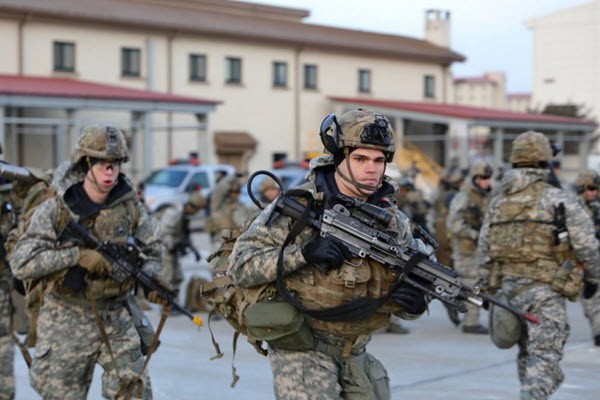
Camp Humphreys, South Korea. (February 2, 2023): In this photo by Captain Frank Spratt, Army Specialist Tyler John Vandkirk of C Company, 2nd Battalion, 1st Infantry Regiment, 2nd Stryker Brigade Combat Team, 2nd Infantry Division begins moving toward a UH-60M Blackhawk helicopter from C Company, 2nd Battalion, 2nd Aviation Regiment on the runway of Desiderio Airfield, Camp Humphreys, South Korea.
A total of 130 Soldiers were transported in UH-60M Blackhawk and CH-47F Chinook helicopters to practice air insertion techniques and link up procedures as part of a combined arms team.
The 2nd Infantry Division, known for its distinctive Indianhead shoulder patch, has the primary mission of pre-emptively defending South Korea in the event of an invasion. There are approximately 17,000 soldiers in the 2nd Infantry Division, with 10,000 of them stationed in South Korea, which accounts for about 35% of the United States Forces in Korea.
The Division is unique in that it is the only U.S. Army division that is made up partially of South Korean soldiers called KATUSAs (Korean Augmentation to the U.S. Army). This program began in 1950 by agreement with the first South Korean president, Syngman Rhee. Some 27,000 KATUSAs served with the U.S. forces at the end of the Korean War. As of May 2006, approximately 1,100 KATUSA soldiers serve with the 2nd Infantry.
The Air Insertion, extraction, escape, and evasion techniques are used by America’s elite warfighters to deeply penetrate enemy territory by air, water, or land. In the Army, Rangers are typically inserted before the main attack to conduct surveillance and to assist attacking aircraft of the main force.
The 2nd Divisions soldiers practiced how to insert and extract forces quickly and with great skill to avoid casualties. The most rapid form of insertion is by air, with Army. Rangers and their equipment delivered by parachute (static-line or freefall technique), fixed-wing aircraft (airlanded), or helicopter (airlanded, parachute, or rappelling).
In wartime, the Rangers insert behind enemy lines and use deception, speed and mobility to suppress enemy weapon systems threatening the incoming raiding force, Equally challenging is extracting these elite warriors, often under enemy fire.
The soldiers flew from Camp Humphreys, home to the Desiderio Army Airfield, the busiest Army terminal in Asia. With an 8,124 feet runway supported by several U.S. Army transportation and tactical units, Camp Humphreys hosts the Combat Aviation Brigade of 2nd Infantry Division located on 3,454 acres with 500 buildings and amenities.
The base is operated under an agreement in 2004 with the South Korean government to place U.S. troops outside the range of North Korean artillery. It is the largest U.S overseas military installation.


